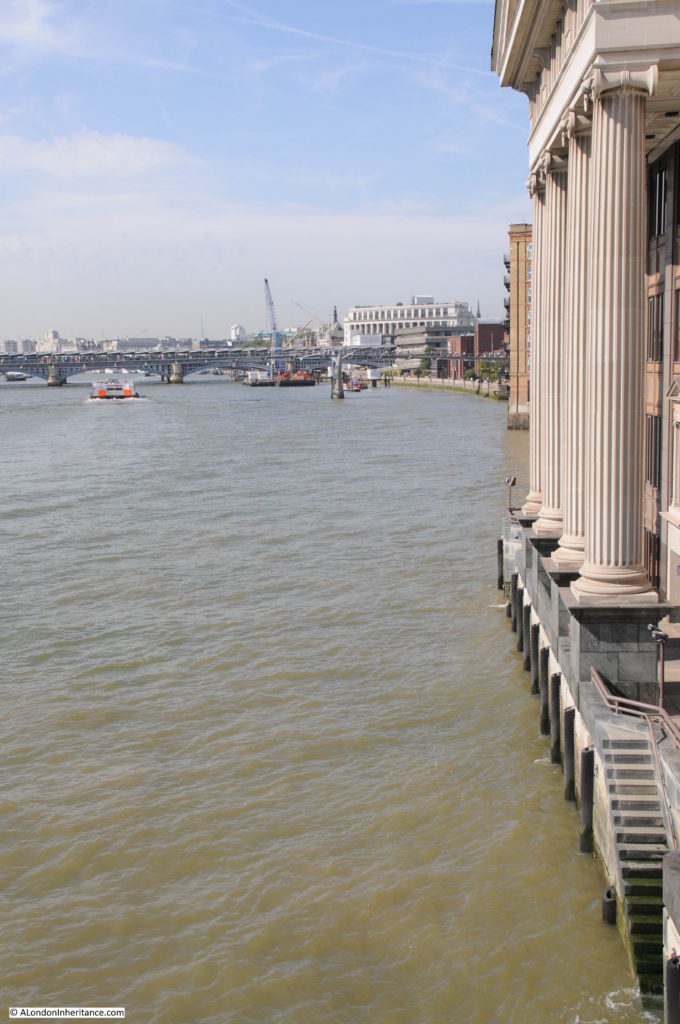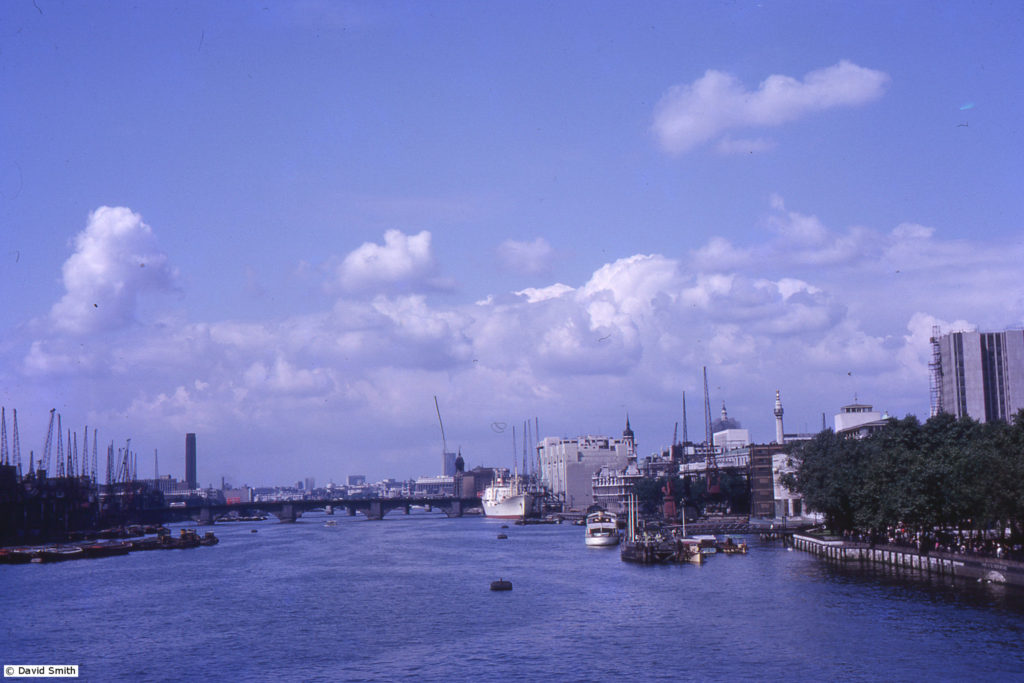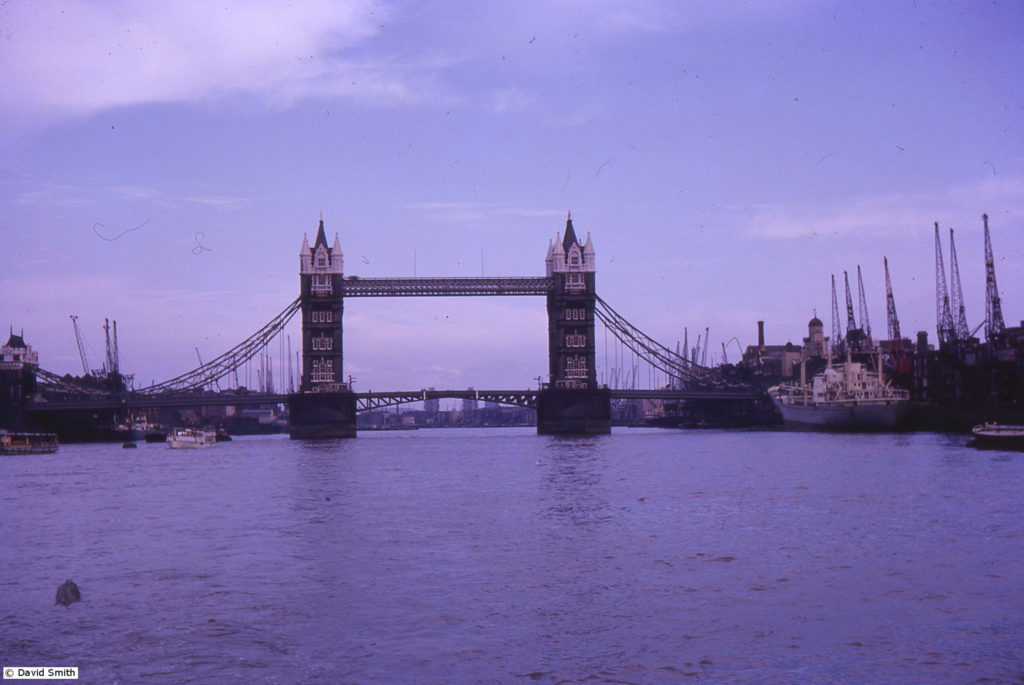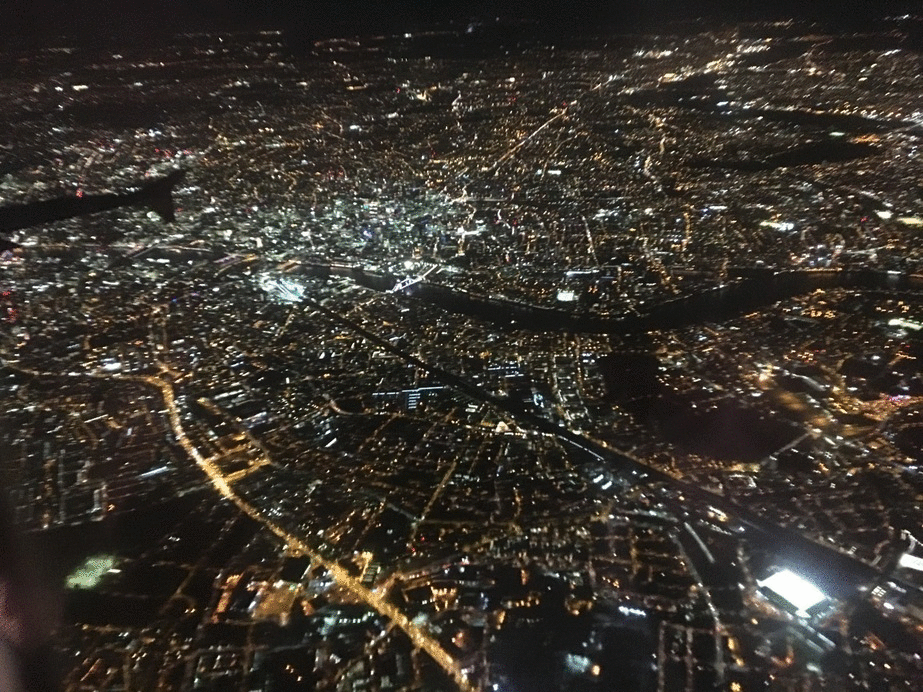I have been travelling and working outside of the country for some of the last two weeks, so my apologies that this is a rather brief post.
Long before the docks running east along the River Thames from Tower Bridge were built, the docks of London lined the river in the heart of the City. Large ships could only travel as far as London Bridge, so to get to the warehouses further west along the river, goods had to be moved onto barges which could then travel underneath the bridges.
As the size of ships and the number visiting London grew, the London Docks, West India Docks, Royal Victoria Docks etc. diverted trade from the centre of the City, however the warehouses along the river west from Tower Bridge continued on until gradually closing during the last decades of the 20th century.
There were a large number of warehouses lining the river between Southwark and Blackfriars Bridges and some of my father’s photos show one of these warehouses in action.
This was the view, looking west from Southwark Bridge. The Vinter’s Company Hall is on the extreme right of the photo and just past this is a barge being unloaded with sacks being carried by crane into the warehouse.
To save space, the cranes were generally mounted on the side of the warehouse. Barges would be taken alongside and goods transferred to and from the barge. If you look to the top right, the control cabin of the crane can be seen along with a man in what appears to be a white shirt operating the crane.
This is the same scene today. The riverside facade of the Vinter’s Hall was rebuilt in the 1990’s. In the distance, the curved Unilever House can be seen on the right and on the left, Shell Mex House.
This is a wider view of the river. The Oxo Tower is standing clear on the south bank of the river.
This is the same view today. The Oxo Tower is still there, but is hidden behind the developments on the south bank.
My father walked a bit further along Southwark Bridge and took the following view looking back at the warehouse. This shows the way cranes were installed on the edge of the buildings. The length of the boom was needed to reach barges moored in front of the warehouse and to reach the top floors of the warehouse. This avoided the need to transport goods between floors within the warehouse.
The same view today.
Although very little is left of the old warehouses that once covered so much of the banks of the river, if you look down on the river edge at low tide, you can often see large areas of white chalk. To provide a stable and flat surface on which the barges could settle at low tide whilst moored alongside the warehouse, chalk was compacted into the surface of the river bank.
Reading accounts of the river during the 18th and 19th centuries, it is hard to believe that the river was once so busy. A couple of prints from the British Museum show an amazing number of vessels and considerable activity on the river. It was the high number of ships, growth in the size of ships and lack of warehouse and mooring space along the river in the heart of the city that resulted in the development of the large docks east of Tower Bridge in the 19th century.
This print from 1841 shows London Bridge with Southwark Cathedral on the left and the Monument on the right.
A few weeks ago I was contacted by David Smith whose mother had taken a number of photos in London during the early 1960s.
They are all in colour and provide some fascinating views of the city and I am very grateful to David for letting me publish some of them.
The following photo is of the warehouses just a bit further along the river towards Blackfriars Bridge. In the background is St. Paul’s Cathedral with the dome covered in scaffolding – I have not seen a photo of this before.
The warehouse on the left with the four red cranes and red doors and windows is the Sunlight Wharf of the LEP Company and LEP Transport Ltd.
When the LEP warehouses were redeveloped in the 1980s, the LEP Group published a fascinating history of the area on which the warehouse had been built. The book provides an insight into the operation of the warehouse:
“The four swinging cranes at Sunlight Wharf served an incessant queue of barges maneuvering for a position at the wharf. Cargoes varied from animal pelts to Polish onions, which were unloaded straight out of the barges into hinged flaps outside the doors of the appropriate floor of the warehouse. The fifth floor of the warehouse remained exclusively offices, the other floors were used for storage and as a Bond warehouse. After the Second World War the scene changed, the number of barges diminished and the ten ton Butters crane replaced the four swinging cranes. This could cope with a greater load and could unload straight from a barge into a waiting vehicle. It was for many years the only – and the last – working crane on the City’s riverfront. It was dismantled in January 1983, defeated by containerisation. Likewise Sunlight Wharf had the distinction of being the last wharf operating as such in the City.”
The Butters crane is the one immediately to the left of the LEP Sunlight Wharf buildings.
I took the following photo of the crane and Sunlight Wharf buildings just before demolition. I was walking along the new White Lion Hill which had been constructed as part of the development of the area to lead down from Queen Victoria Street to the Embankment. See here for the full post and photos of the area and excavations of Baynard’s castle.
Included in the photos that David sent was the following taken from Tower Bridge. Note the cranes along the southern bank of the river and the large ship docked on the right of London Bridge.
And the following view from London Bridge. The cranes on the right are along the warehouses that backed onto Pickle Herring Street.
Another view, again showing the size of ship that would moor in this stretch of the river, alongside the warehouses at Pickle Herring Street.
The cranes along this stretch of the river have long gone. Some of the old warehouse buildings still survive, but now serve other purposes. The majority of the docks east of Tower Bridge have also closed apart from Tilbury Docks as the size of ships continued to grow along with the large areas of land needed for container storage. I hope to cover the London Docks in far more detail in the future.
My thanks again to David Smith for letting me see and publish some of his mother’s photos.
I mentioned at the start, that this is a brief post as I have been travelling for work over the last few weeks. I flew back into Heathrow one evening last week and had a window seat on the right side of the plane as the route was over the south of London providing a fantastic view of the city on a clear night.
Flying over London provides a wonderful opportunity to see the layout of the city, the river, rail tracks, buildings etc. and at night the city looks fantastic. Whilst the majority of other passengers seemed oblivious to the view of London, I had my eyes and phone pressed against the window taking photos as the plane flew over south London, and consolidated the photos into the following video.
The view starts with the river and Tower Bridge as well as the dark thin line of the very straight rail track into London Bridge station, flying to the west and the red lit London Eye and ending with Chelsea Bridge and the dark of the park in front of the Royal Hospital Chelsea.
In centuries past, travelers to London from abroad would have traveled up the Thames and landed at one of the many steps along the river. Now they fly over the city and land to the west.















Yet another interesting post,Admin. I especially liked the flying view of London because, at the start,you can see Millwall’s ground all lit up,as they had a home match that day.
Thanks Jo, and for pointing out Millwall’s ground. Stands out well all lit up and next to the dark line of the railway running from London Bridge.
Hi David,
I notice that the captions for images 7 and 8 are round the wrong way, i.e. Pickle Herring Street ( where incidentally there were a number of fish stalls) is the image that you’ve associated with the large ship actually shown in the neighbouring photograph, swap the captions and you’ve done it. My own father who was born in 1924 actually grew up around the Shad Thames an Pickle Herring Streer area, playing amongst the barges along the Thames, an activity made famous by the 1950 Film The Mudlarks. His mother apparently worked on the family fish stall on Pickle Herring Street, as mentioned above and not suprisingly contracted severe arthritis in her hands, working in such freezing conditions in the winter here, must have been dreadful. I recall walking around Shad Thames in the 1980’s before major redevelopment and restoration and finding abandoned Wharehouses still with the produce they handled pouring out of rotten doorways, this included flour that probably would have been used by the nearby Peek Freans and Jacobs biscuits factories.
Best Regards,
Jerry,
Hi Jerry, thanks for pointing this out. Reading the text again I did not make clear in the caption that it refers to the following photo. Both the last two photos are looking east towards Tower Bridge so Pickle Herring Street should be on the right. Interesting about your family connections, that must have been so very difficult working outside in all weathers. Hard to believe now when walking along the open space that was once Pickle Herring Street. It was sad in the 1980s seeing all the warehouses in such an abandoned state, just waiting their fate.
Great piece about the warehouses. Worth remembering that in January 1965, when Sir Winston Churchill’s funeral barge travelled down the Thames, it was regarded as a significant tribute that the riverside cranes were all dipped downwards as a mark of respect! Film of that part of the funeral showed how many cranes there were, too.
Beautiful photos.
Great item about the warehouses. Worth remembering that when Sir Winston Churchill’s funeral launch carried his coffin down the Thames in January 1965, the chosen mark of respect for him was for the riverside cranes to be dipped in his honour. The film of the funeral shows how many there were!
Dear Admin .
Just as matter of interest the Butters Crane shown was originally sited at Lep Transport Corny Reach Depot at Chiswick My Dad was a Lorry Driver for Lep’s based at Chiswick, I also worked for a short time as a Wharfman (docker) there . It was dismantled and removed to Lower Thames St in the early 6O’s. As a side issue Lep Transport also had the last working Steam Crane which was also based at Corny Road and used for unloading barges and for loading lorries .It run on rail tracks laid alongside the wharf. The last driver of it was a wonderful character with the unusual Christian name of Pearance Smith. I can still recall the sounds it used to make when lifting loads from lorries or barges along with smell of the steam. Happy days
Your article about Sunlight Wharf brought back memories. My first job after leaving school in 1973 was with Lep. At that time although part of the building was still used for warehousing most had been converted into offices. The fifth floor was where the original offices were, with three large bays each housing a different department. The roof contained huge skylights to let in the sun. I remember the address, Sunlight Wharf, 37 Upper Thames Street, London EC4 and the phone number, 01 236 5050, previously Central 5050! As well as Lep, there were two other companies in the building, European & General Express and Crowe & Co. EGE were fully owned by Lep, some clients were Lep’s (buff files) and others EGE’s (green files). That was the only difference as far as I could tell. Crowe were on the third floor and Lep had part ownership but other than that they were separate and had their own staff.
Excellent article……a little morsel of interest, I used to walk across London Bridge to the city,and there
was often a ship moored right by Adelaide House, that was involved in the banana trade,it may have been a Fyffe’s vessel…..A friend of mine used this ship for holidays to, I believe the West Indies,as it had comfortable space laid aside for paying passengers..I would like to hear more about this alternative style of travelling…